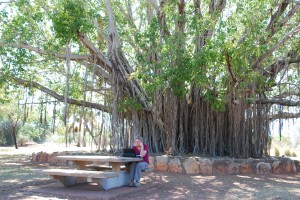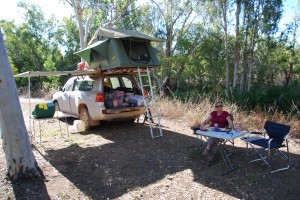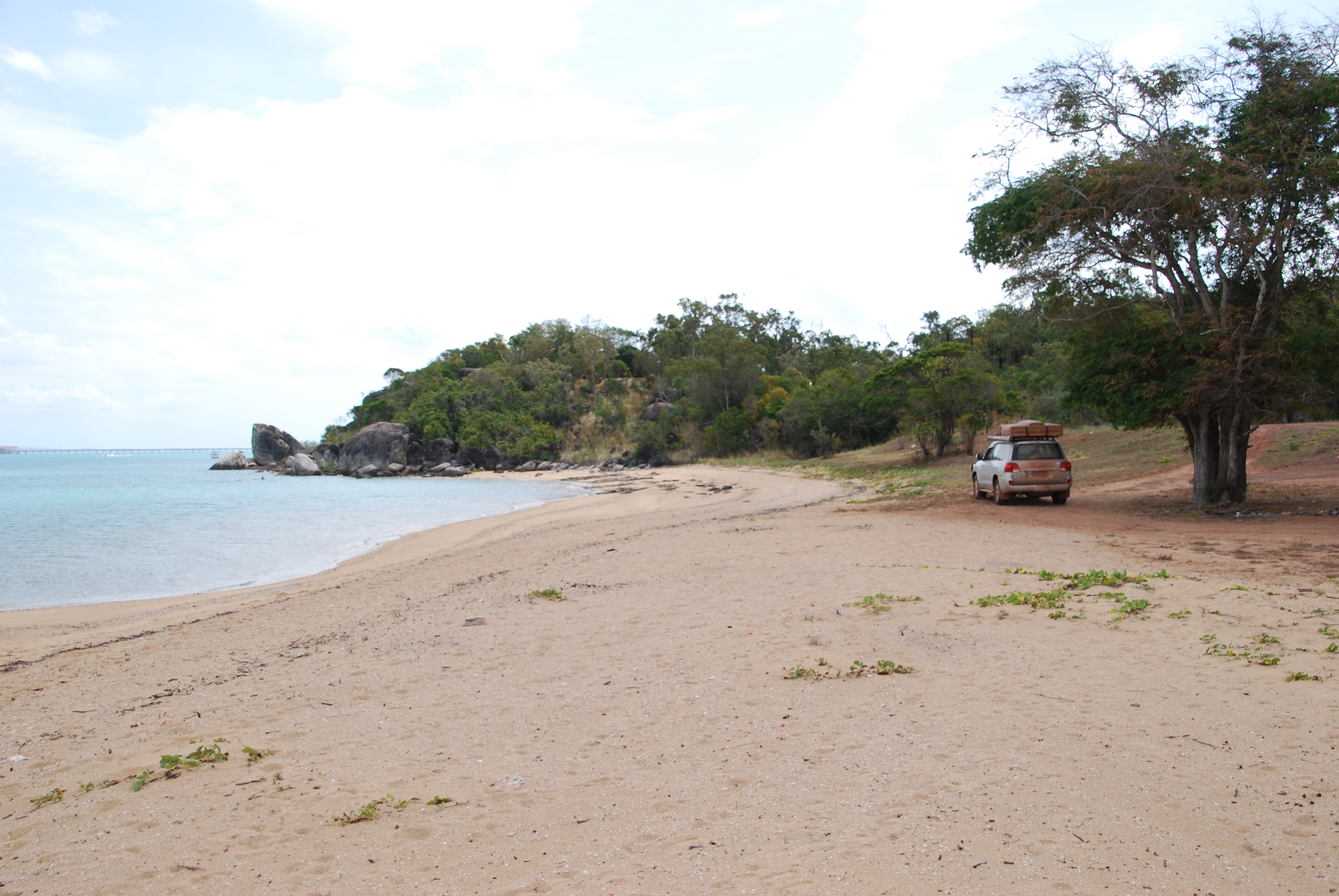Exploring Arnhem Land

Julie intently reading the blog from the shade of a giant tree before we tackle the long drive into Arnhem Land
Arnhem Land is a vast part of the Northern Territory, bigger than many countries and at the very heart of the origins of civilisation on this continent. Today it is owned and managed by a range of Aboriginal clans that have occupied this land for tens of thousands of years. But visiting this land is not easy; there are permits to obtain, incredibly long dirt tracks to drive, restrictions on alcohol, the heat, the dust, the remoteness. We overcame all these challenges and had a fascinating week in this ancient corner of Australia.
Our experience with Arnhem Land began before we left Sydney. We applied for a permit online, a bit apprehensive since we had heard they were hard to obtain. Other Aboriginal lands in NT had already told us all their permits had been allocated. But the Northern Land Council, or NLC, soon confirmed our permit for seven days and we were on our way (in fact, we had to alter the dates later on and they did this for us over the phone – very easy).
But the drive from the safety of the bitumen on the Stuart Highway to our destination, the mining port town of Nhulunbuy (formerly known as Gove) is an astonishing 750 klms, about the distance of Newcastle to Brisbane or Los Angeles to San Francisco. And almost all of this road is dirt, sometimes in quite good condition after having recently been graded but sometimes an absolute goat track. As we learned quickly, it takes persistence and stamina to visit Arnhem Land.

Resting in the shade of our truck at Mainoru Store after the first leg of our long drive into Arnhem Land
There is only one place along this road where we are permitted to camp, at a place called Mainoru Store, and we pulled in there early on the first afternoon of our permit. We camped under the huge paperbark gums on the banks of the Mainoru River and shared stories around the fire with a long time Nhulunbuy resident who was returning home with his young family after a holiday from working at the huge bauxite mines of Gove.
The next day saw us travel 500 klms along this road, through rolling hills and across flat plains, crossing a few substantial rivers as well as many dry ones, take photos of the palms and gums and termite mounds (of course), the wild donkeys, herds of brumbies and huge buffalos with aggressive dispositions. We would be lucky to meet one vehicle per hour and referred to them as traffic, each time being reminded of the huge plume of dust all vehicles, including us, are throwing up as we pass.
From our observation, and views of others we spoke to, the Aborigines are not so much managing this vast unmanageable land as they are just preserving it by not using it or allowing others to use it. It is almost an unlimited space still in its absolute original form, and appears that it will remain this way for a long time.
At long last, and after watching the vegetation become thicker and more tropical, we came to our destination, the mining town of Nhulunbuy which is the principal town of Arnhem Land (or East Arnhem Land to be exact). Nhulunbuy has a population of about 4,000, largely the result of the huge bauxite mining operation on the peninsula. The town is mainly geared around supporting its mine employees and their families. All supplies are brought in by barge in the middle of the week (and store shelves can be quite empty in the days beforehand), there tends to be only one of each service (one petrol station, one newsagent, etc) but there are numerous schools to accommodate the young families living there and to support the local indigenous people getting their kids to school.
Nhulunbuy is also the headquarters of the various groups and government bodies who manage Arnhem Land, including issuing the necessary permits required of all visitors. As we arrived on a Saturday afternoon we had to wait until Monday morning to get our local permits. That allowed us a lazy Sunday in the town camp behind the Walkabout Lodge, doing washing, emails, swimming in the complex’s pool, suffering the heat but also exploring this quiet but unique town. The evenings were spent treating ourselves at the local clubs for dinner and we struck up many good conversations (some over a few beers) with the other travellers in the camp ground. If you had made it to Nhulunbuy by road you it was something to celebrate.
The next few days would be spent exploring some of the beautiful places available for travellers to visit with the permits available to us and try to absorb as much of the local culture as possible. After all, its not the type of place that one visits frequently and we want to make the most of this rare opportunity. And of course we are desperately looking forward to that long drive back to civilisation.
As an extra final point….this is my 100th blog posting since setting up this site in 2010. When I started this project I never thought it would grow so much and have so many followers. Julie and I have used it to document our travels and share our experiences with family, friends and everyone else who reads it. It’s been great fun writing it and hopefully fun reading it. May there be hundreds more.







